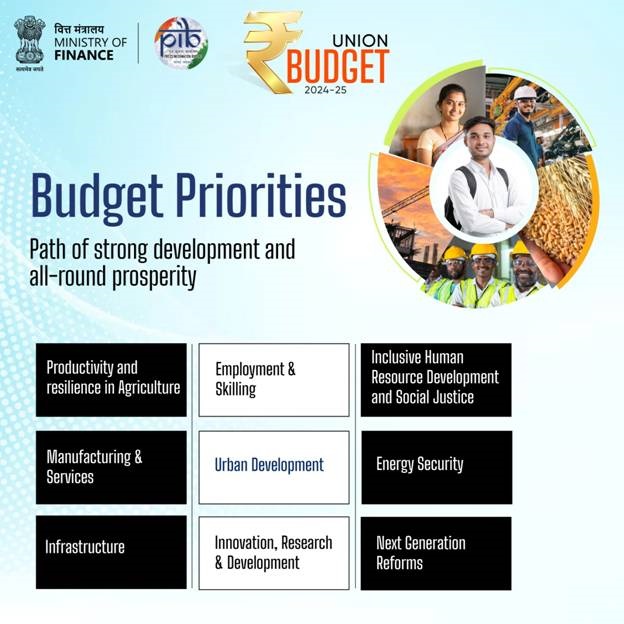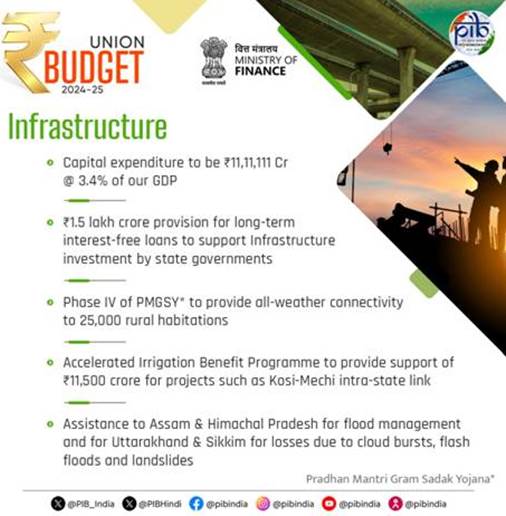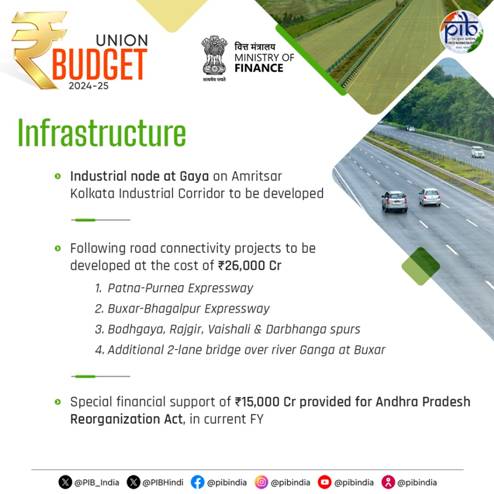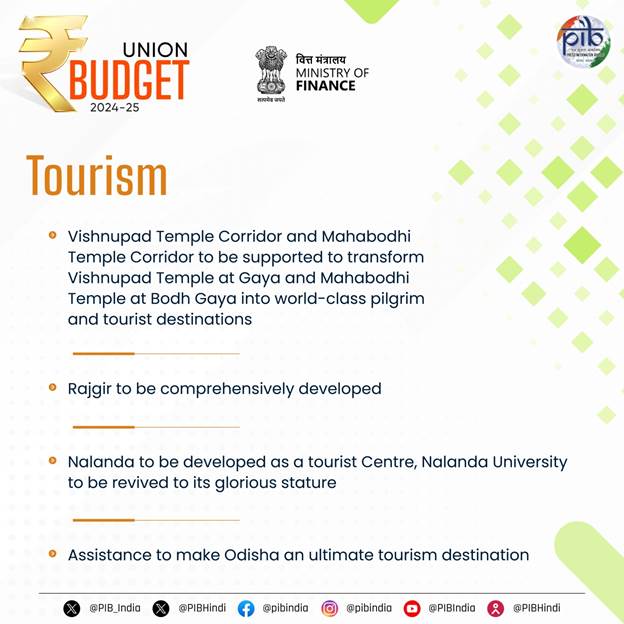The Union Minister of Finance and Corporate Affairs, Mrs. Nirmala Sitharaman, presented the Union Budget 2024-25 in Parliament today, July 23, 2024. This budget envisions sustained efforts across nine key priorities to generate ample opportunities for all, in pursuit of ‘Viksit Bharat.’ The key priorities include Productivity and Resilience in Agriculture, Employment & Skilling, Inclusive Human Resource Development and Social Justice, Manufacturing & Services, Urban Development, Energy Security, Infrastructure, Innovation, Research & Development, and Next Generation Reforms. Among these, significant announcements have been made to the infrastructure sector.
Infrastructure Development


The Finance Minister emphasized the significant investment the Central Government has made over the years in building and improving infrastructure, which has had a strong multiplier effect on the economy. The government will maintain strong fiscal support for infrastructure over the next five years while balancing other priorities and fiscal consolidation. An allocation of ₹11,11,111 crore for capital expenditure, which is 3.4 per cent of GDP, has been made this year.
The government will encourage states to provide similar scale support for infrastructure, aligning with their development priorities. A provision of ₹1.5 lakh crore for long-term interest-free loans has been made this year to assist states in their resource allocation. Investment in infrastructure by the private sector will be promoted through viability gap funding and supportive policies and regulations. A market-based financing framework will also be introduced.


Despite many financial innovations in infrastructure financing in recent years, capital expenditure by the Union and State Governments still plays a central role in funding large-scale infrastructure projects. The capital expenditure of the Union Government increased by 2.2 times from FY21 to FY24 (PA) while that of the State governments increased by 2.1 times during the same period.
The net flow of funds to infrastructure sectors through bank credit between March 2023 to March 2024 was only around ₹79,000 crore, much less than the GBS by the Union Government for either railways or roads. However, the credit growth to infrastructure sectors in FY24 recovered to 6.5 per cent, as against the growth of 2.3 per cent in FY23.


The gross inflow of external commercial borrowings to infrastructure sectors also picked up to USD 9.05 billion in FY24, as against an average of USD 5.91 billion during FY20 to FY23. The resource mobilization by infrastructure sectors through debt and equity issuances in the capital market was just over ₹1,00,000 crore during FY24. Real estate investment trusts (REITs) have raised ₹18,840 crore from 2019 to 2024, while Infrastructure investment trusts (InvITs) raised a total of ₹1,11,294 crore in the last five years (2019-2024).
Existing Mechanisms for Fostering Public-Private Partnerships (PPP)
Public Private Partnership Appraisal Committee (PPPAC): Apex body for appraisal of central sector PPP projects. 77 projects with a total cost of ₹2.4 lakh crore were recommended from FY15 to FY24.
Viability Gap Funding (VGF): Assistance to financially unviable but socially/economically desirable PPP projects. 57 projects costing ₹64,926.1 crore were granted in-principle approval and 27 projects costing ₹25,263.8 crore were granted final approval from FY15 to FY24. Total VGF approval of ₹5,813.6 crore (both Union Government & State share) from FY15 to FY24.
India Infrastructure Project Development Fund Scheme: Financial support for project development of PPP Projects. Notified in November 2022 with a total outlay of ₹150 crore for three years from FY23 to FY25. 28 proposals have been approved.
Focus on Tourism Development


Union Minister for Finance and Corporate Affairs, Mrs. Nirmala Sitharaman emphasized the importance of positioning India as a global tourist destination. “Our efforts in positioning India as a global tourist destination will also create jobs, stimulate investments, and unlock economic opportunities for other sectors,” she stated.
Mrs Sitharaman announced the comprehensive development of the Vishnupad Temple Corridor and the Mahabodhi Temple Corridor, modelled on the successful Kashi Vishwanath Temple Corridor, to transform them into world-class pilgrim and tourist destinations. She also highlighted initiatives for Rajgir, which holds immense religious significance for Hindus, Buddhists, and Jains, and for Nalanda, aimed at reviving Nalanda University to its former glory.
The Union Minister also noted Odisha’s scenic beauty, temples, monuments, craftsmanship, wildlife sanctuaries, natural landscapes, and pristine beaches, stating that the government will assist in their development.
Railway Infrastructure and Industrial Development
For FY 2024-25, the government has allocated a record ₹2,62,200 crore as Capex for Railways. A significant portion of this fund is earmarked for safety-related activities. Railways have achieved several milestones in infrastructure, including commissioning 31,180 track kilometres over the past 10 years and electrifying 41,655 Route Kilometers (RKMs) since 2014.
Additional funds have been allocated to promote industrial development, supporting infrastructure for industrial clusters at strategic nodes such as Kopparthy on the Vishakhapatnam-Chennai Industrial Corridor, Orvakal on the Hyderabad-Bengaluru Industrial Corridor in Andhra Pradesh, and Gaya on the Amritsar-Kolkata Industrial Corridor in Bihar.
Railways have adopted a new approach to infrastructure development, identifying Economic Railway Corridors, Port connectivity corridors, and High Traffic Density corridors under the PM Gati Shakti Mission to enable Multi-Modal connectivity, enhance capacity, decongest high-density networks, reduce logistics costs, and improve passenger experience and safety.
Cruise Tourism and Port Development
The Union Budget 2024-25 places significant emphasis on the growth of cruise tourism and the development of ports as part of its broader infrastructure strategy. Recognizing the immense potential of India’s coastal regions, the government has committed substantial resources to enhance port infrastructure, making it more efficient and capable of accommodating large cruise liners. This initiative aims to boost cruise tourism, attracting international tourists and providing them with world-class facilities and experiences. Key ports are being upgraded with modern amenities and improved connectivity to nearby tourist attractions, ensuring a seamless travel experience. Additionally, the development of new cruise terminals and the enhancement of existing ones will facilitate increased tourist footfall, stimulate local economies, and create numerous employment opportunities. These efforts will position India as a leading destination for cruise tourism, leveraging its rich maritime heritage and diverse coastal landscapes.
The Union Budget 2024-25 underscores the government’s commitment to advancing economic growth through robust infrastructure development, with a significant focus on tourism, railways, and industrial infrastructure. These initiatives are poised to create jobs, stimulate investments, and unlock economic opportunities, reinforcing India’s path to becoming a Viksit Bharat.
Also Read
Residence de l’Evėché Opens its Doors
Watch on Youtube
